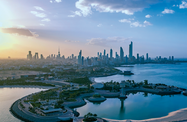Kuwait can look back on 2011 as a year characterised by higher than expected oil revenues and developmental progress despite domestic political wrangling and turmoil in the global market.
As OPEC’s third largest producer, pumping around 2.9m barrels of oil per day, Kuwait benefitted from rising demand bolstered by the loss of Libyan exports to conflict as well as global supply concerns. Crude oil prices increased 10% in 2011 after climbing 15% in 2010, with Brent-oil futures for February settling at $108.09 a barrel on the London-based ICE Futures Europe exchange in the same month.
Confidence in oil prices was reflected in an exceptional budget for 2011-12, announced in January of last year, with projected spending of KD19.4bn ($69.5bn), a 19% jump from the previous year. Though seen as ambitious, last month monitoring firms reported that a budget surplus in the first six months of the 2011-12 fiscal year would reach at least KD8.9bn ($31.9bn). The 2011-12 budget was based on a conservative oil price of $60 per barrel.
One focus has been so-called mega-projects, on which the government has planned an outlay of KD37bn ($132.6bn) by 2014. Kuwait’s Supreme Petroleum Council (SPC) in June approved two long-stalled oil initiatives worth more than KD8bn ($28.7bn). The newspaper Al Jarida said the SPC approved the building of a new refinery and the upgrading of two of three existing refineries to raise output and produce cleaner products.
In November, the Ministry of Public Works confirmed that another 300 projects were under way at an annual cost of KD500m ($1.8bn), as part of the State Development Strategy, according to the Kuwait News Agency (KUNA). In an interview with KUNA, Fadhel Safar, the minister of public works and the minister of state for municipal affairs, explained that planned initiatives included “several mega and vital projects, such as construction of a passenger terminal at the airport, securing treated water for diverse usage, Mubarak Al Kabeer Port and developing the islands of Boubyan and Failaka”.
However, market research firms have stressed the need to tackle the debts of investment companies to get vast infrastructure development plans back on track. Bloomberg reported in December that about 10% of bank lending in Kuwait is to investment companies, some of which have defaulted since the onset of the global financial crisis, hampering the $125bn development plan.
“Kuwait’s government has announced an extensive investment programme for the next four years, but bureaucracy and legacy exposures of distressed investment companies may subdue the economic recovery,” wrote a team of analysts at Moody’s Investors Service in a July report.
However, the political processes were also hampered in 2011 by disputes in parliament, with opposition lawmakers protesting in November against the rule of Sheikh Nasser Al Mohammed Al Sabah, who later that month resigned as prime minister.
Former defence minister Sheikh Jaber Al Mubarak Al Hamad Al Sabah was quickly selected for the post, and he has pledged to “serve Kuwait’s higher interests, and push the national action for the sake of comprehensive development to achieve prosperity,” according to regional media.
The political tensions are believed to have had an impact on the Kuwait Stock Exchange (KSE), with many investors awaiting the outcome of parliamentary elections in February 2012. The KSE price fell by 16.14% by the end of September 2011, reaching 5833.10 points, with regional political events and the eurozone crisis cited as major contributing factors. In terms of year-to-date performance up to September 2011, the index declined by 19.28%.
However, the KSE did benefit from stability in the banking sector, with profits or slight dips reported by most banks and international ratings agencies giving a boost to two major lenders in December alone.
While Fitch affirmed the Industrial Bank of Kuwait with a long-term issuer default rating of “A+” with a stable outlook, Standard & Poor’s raised its long- and short-term counterparty credit ratings on Kuwait-based Gulf Bank. The latter saw an 8% year-on-year (y-o-y) rise in third quarter profits to KD9.1m ($32.6m), with the National Bank of Kuwait (NBK) reporting a third-quarter net profit of KD78.9m ($283m), compared with a forecast of KD74.7m ($267.7m).
The central bank was unable, however, to lower inflation in 2011, with the rate edging up an annual average of 4.7%, according to November projections by the NBK. The Central Statistical Office (CSO) had reported a month earlier a rise of 150 points in the consumer’s price index for September 2011, compared to 143.5 points in September of 2010. Figures from October showed food prices rose 9% y-o-y; clothing, 4%; and education and health services, 3.4%; according to the CSO.
The rise in prices has not dampened growth in real estate, with KUNA reporting in November the sector’s third-quarter performance had bucked fluctuation trends in the KSE. Sales activity in the real estate sector rose by KD60m ($215m) in October, a 43.8% y-o-y increase over last September.

